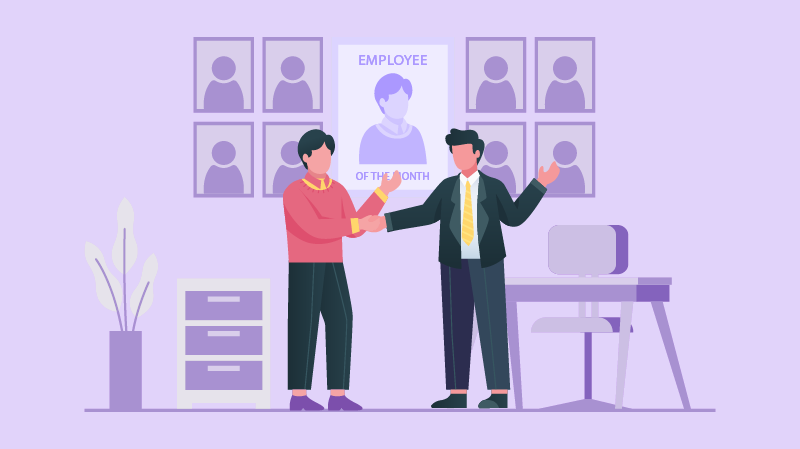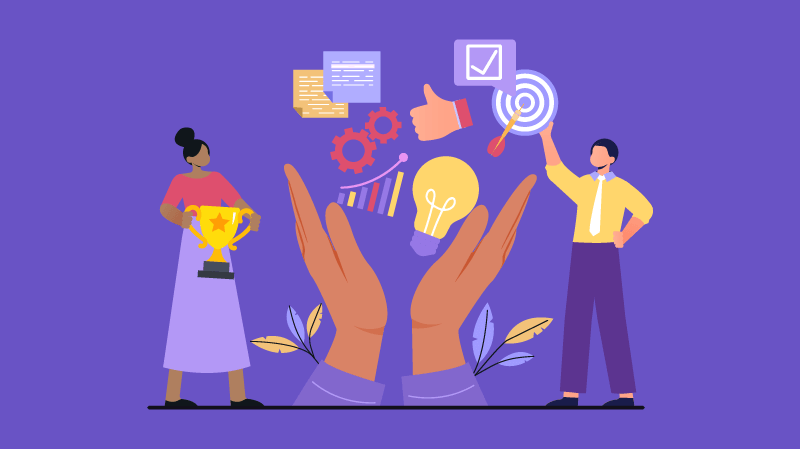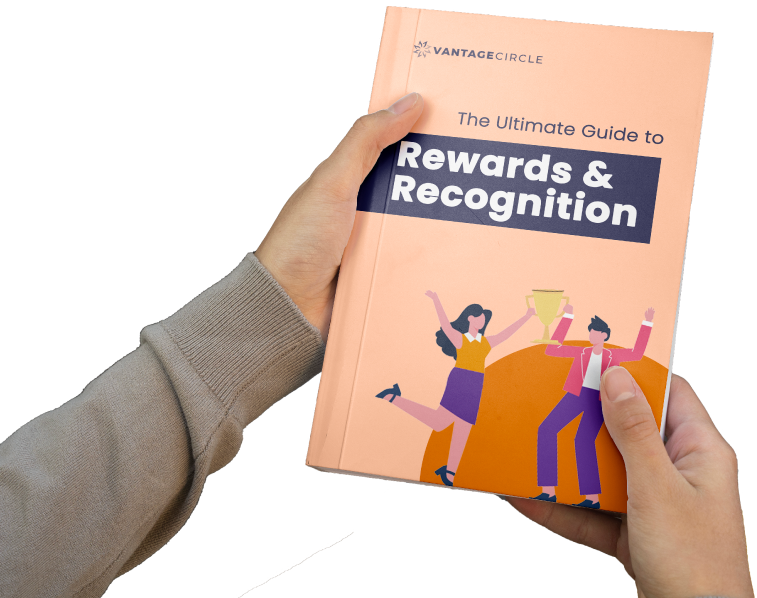Recognition That Drives Business Performance: Aligning Employee Behavior with Organizational Goals

A Global Employee Recognition and Wellness Platform
Every quarter, a familiar scene plays out in conference rooms across corporate America.
Leadership teams spend hours crafting strategic priorities, then watch as their recognition programs reward completely different behaviors.
Last month, I witnessed this firsthand at our own all-hands meeting—celebrating "Employee of the Month" for punctuality while our biggest competitive challenges demanded innovation and risk-taking.
This disconnect isn't unique to us.
Companies everywhere are recognizing individual achievement while desperately needing collaboration, rewarding compliance while requiring agility. And the cost of this misalignment is staggering: globally, disengaged employees cost the economy around $8.8 trillion—nearly 9% of global GDP—according to Gallup's data.
That's a glaring wake-up call.
If performance isn't translating into engagement, something fundamental is broken. We can't afford to treat recognition as a one-time thing or think of it as a feel-good sentiment anymore.
In today's rapidly evolving workplace, recognition has become a strategic lever.
After years of observing this pattern—both in our organization and across the industry—I've become convinced that recognition is one of the most underutilized strategic tools in business.
When done right, it doesn't just elevate individuals—it amplifies results by correcting misalignments, reinforcing desired behaviors, and anchoring culture in performance. When we get it wrong, we're essentially incentivizing people to work against their own success.
A. The Recognition-Performance Connection
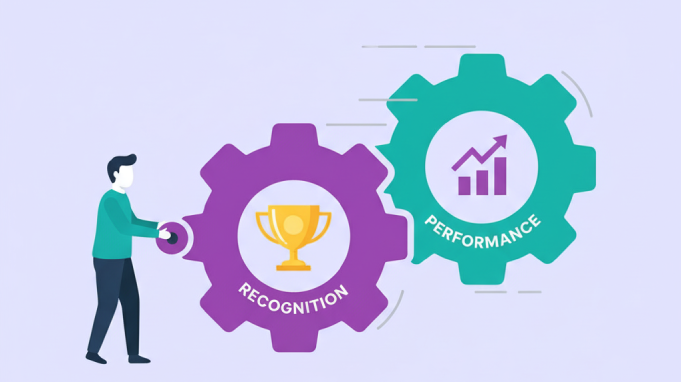
Recognition is tightly correlated with engagement, retention, productivity, and ultimately profitability. The numbers are self explanatory:
-
Managers who excel in recognizing their employees can create a 40% more engaged workforce. This is in comparison to those who do not recognize their workforce.
-
Employees experiencing high-quality recognition are 45% less likely to leave their organization within two years. This signifies the high impact of recognition in a workplace and how it can drive behaviors.
-
More frequent, meaningful feedback and recognition is powerful: when employees get recognition at least weekly, 61% are engaged, compared to only 38% who receive feedback but not recognition. (Source)
These aren’t feel-good stats—they underscore recognition as a proven business accelerator.
But the problem is many companies still do not acknowledge these numbers. They still silo recognition as an HR checkbox.
However, when they integrate it as a strategic alignment it transforms soft activities to hard business results.
Why Alignment Matters

I have come across a certain question most of the time: When is employee recognition most effective?
My answer has always been a simple yet understandable one; “Recognition works best when it’s aligned with organizational goals.”
When recognition reinforces specific behaviors that drive success, it becomes a powerful tool for improving performance.
-
Recognition tied to outcomes: Instead of just celebrating effort (e.g., working late), focus on rewarding actions that contribute to key business results, such as customer satisfaction or innovation.
-
Example: Recognizing a team for solving a customer pain point leads to higher customer retention and satisfaction, which drives business growth.
Strategic alignment ensures that recognition is meaningful and not just a “thank you.” When connected to the company’s vision and mission, it drives performance.
- When recognition “hits the mark”, employees are 5 times as likely to be connected to company culture, and 4 times as likely to be engaged. (Gallup)
I have always seen and realized that employees need to understand how their contributions impact the organization’s success.
When they bring in the impact it gives them a greater sense of ownership and purpose.
This is the crucial time to align recognition with such behaviors. When you do, it can boost both employee engagement and business performance.
B. Framework: Recognition That Aligns with Goals Using the AIRe Model
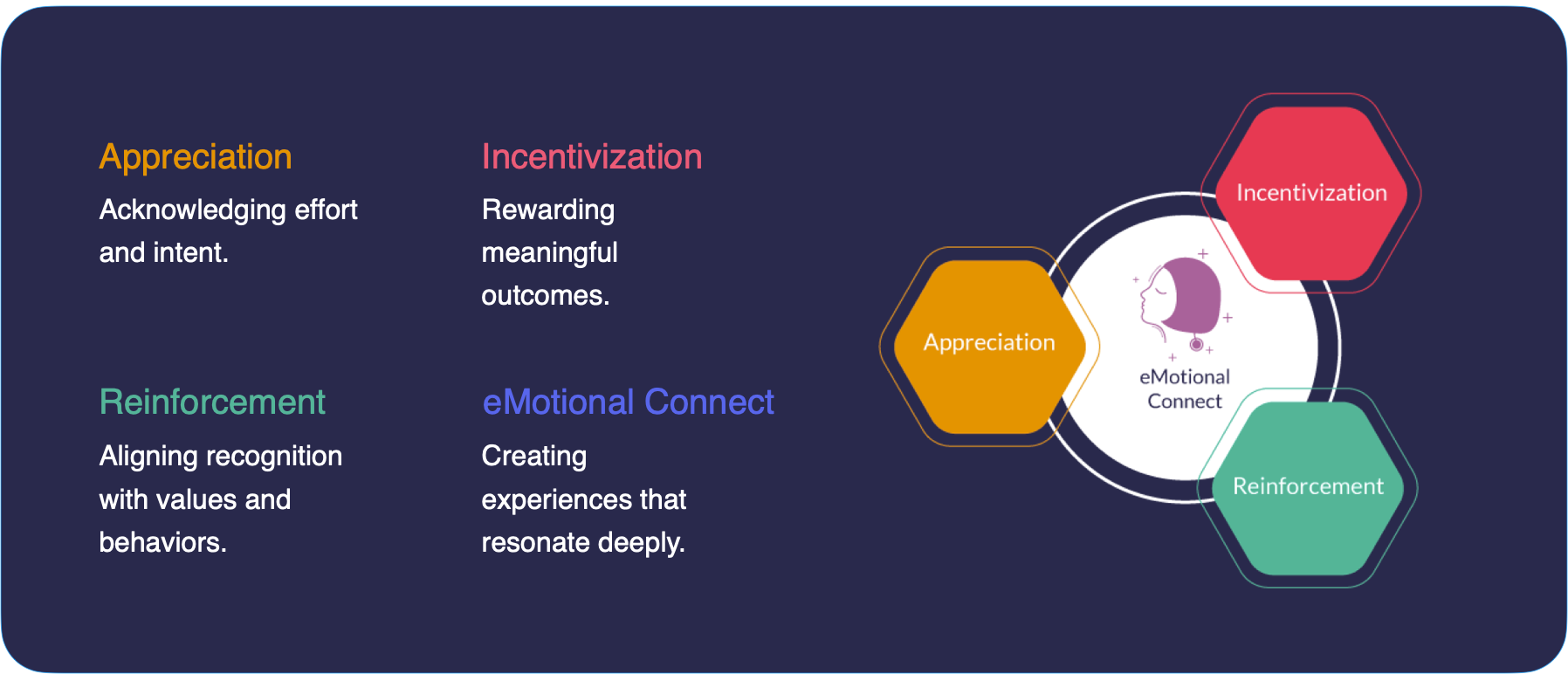
The AIRe framework, which stands for Appreciation, Incentivization, Reinforcement, and eMotional Connect is a powerful tool that helps enhance recognition.
With this framework, organizations can ensure recognition drives the right behaviors and reinforces business priorities.
However, the main question is, how will these four themes help you and your organization?
Our research shows that only 55% of employees experience the complete emotional impact of recognition across all four dimensions—becoming advocates who uplift others. (Source: GPTW x Vantage Circle Report on Recognition Effect)
The answer lies in how each theme directly empowers your organization to drive performance, engage employees, and achieve business goals. Below, we’ll break down how the AIRe framework transforms recognition from a feel-good activity into a strategic business driver:
1. Appreciation
-
What it is: Acknowledging employee’s contributions and valuing their work.
-
How it aligns with goals: Recognizing employees for behaviors that reflect core company values and directly contribute to key business objectives. Currently, only 57% of employees feel truly appreciated at work, representing a significant opportunity for improvement. (Source: GPTW x Vantage Circle Report on Recognition Effect)
-
Example: Appreciate employees who solve problems, assist customers diligently, demonstrate good collaboration, or develop innovative solutions.
2. Incentivization
-
What it is: This is all about making recognition both attractive and desirable. It involves including tangible rewards that add value to recognition.
-
How it aligns with goals: Incentives should be tied to performance metrics that drive business success, such as meeting KPIs, achieving sales targets, or enhancing customer satisfaction.
-
Example: You can offer bonuses or gifts when employees go beyond their limits and achieve their target before the deadline.
3. Reinforcement
-
What it is: Reinforcement involves being consistent in recognizing behaviors that drive positive outcomes.
-
How it aligns with goals: When you recognize the right behaviors that drive results it ensures that they are ingrained in the company’s culture. This enables the workforce to follow them as it revolves around getting acknowledged for doing the right thing.
-
Example: Acknowledge achievements weekly or monthly, highlighting how they contribute to growth or innovation. An informed recognition will enable the employees to understand the areas where they can increase their focus.
4. eMotional Connect
-
What it is: Recognition is the bridge between creating a strong emotional connection between employees and the organization.
-
How it aligns with goals: Employees receiving recognition and feeling valued through recognition increases engagement. In the long run the commitment of employees rises that drives long-term success.
-
Example: Recognize employees in a personalized manner that connects their individual efforts to the company’s overarching mission and vision.
AIRe + Business Goals: The AIRe framework ensures recognition programs utilize all the four themes mentioned above. Doing so will help organizations establish a systematic framework that focuses on cultural well-being while creating measurable business impact.
Want to know more about the AIRe Framework? Click here.
C. Trends Shaping the Future of Recognition
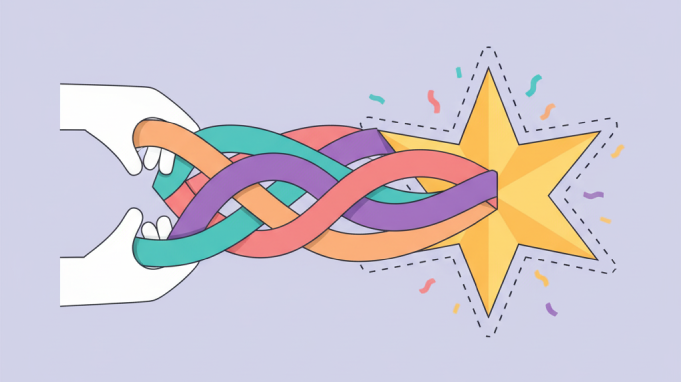
The approach to recognition should change with the evolving workplace setting.
With the growing influence of new trends, recognition has become adaptive and flexible. It is transforming the way we recognize employees.
What are those trends? Let us understand them better.
AI and Personalization
With the growing influence of artificial intelligence, recognition can now be more personalized. AI helps tailor recognition and rewards based on your historical data and individual preferences. This ensures that recognition stays and feels genuine and impactful.
Example: AI can analyze employee rewards patterns and suggest rewards that align with personal milestones or preferences. This creates a deeper emotional connection.
Real-Time Recognition
The traditional approach of recognition in the form of annual or quarterly events is becoming outdated. Employees expect real-time recognition that gives them immediate feedback. This drives higher engagement and motivation while meeting the needs of the modern workforce.
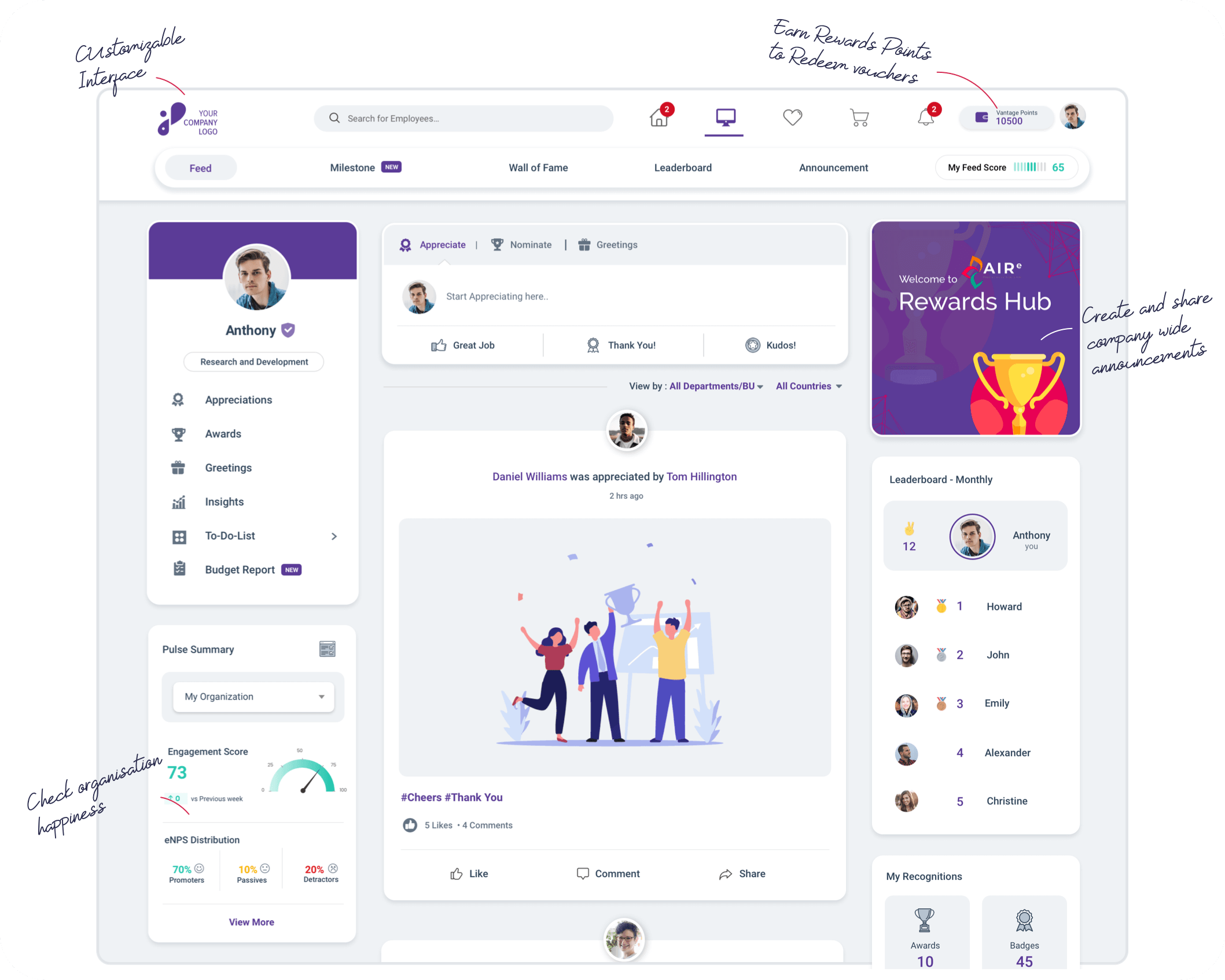
(Source: Vantage Recognition)
Real-time recognition tools ensure employees are celebrated when they’re most engaged, fostering a culture of instant appreciation.
Global yet Local
As companies scale globally, the newer recognition strategy demands consistency, precision, and flexibility. While the core framework of recognition remains the same, smart leaders customize recognition approaches to honor cultural nuances.
Example: Celebrating work anniversaries in one region might look different than in another, but the focus remains on reinforcing behaviors that align with business goals.
Recognition as a Culture Amplifier
Recognition can't be this separate thing we do once in a while—it has to become part of how we naturally operate.
The evidence is clear: Recognition levels have plateaued below 70% industry-wide, but organizations that embed recognition as a culture amplifier see dramatically different results. (Source: GPTW x Vantage Circle Report on Recognition Effect)
When appreciation flows through your daily interactions, it automatically strengthens the exact behaviors that drive your business forward, creating a workplace where people know their worth without question.
Forget those big annual awards shows—the small, consistent moments are where the magic happens. When you catch and celebrate the right actions in real-time, you're building a culture that sustains itself, where your team feels truly seen and stays locked in on the work that actually matters.
D. Leadership Perspective

As a CEO, I want to highlight that the importance of recognition is something that you cannot overlook.
I look around the business world today and honestly, it's barely recognizable from where we were just a few years back. The economy has us all walking on eggshells, nobody can agree on this whole remote work thing, and our teams? They're asking for something completely different from work than what we used to offer.
In the middle of all this mess, something hit me hard: recognition isn't optional anymore. It's literally what separates the companies crushing it from the ones just trying to keep the lights on.
Look, I've spent years in the trenches building Vantage Circle, and here's what I know for sure—recognition is where everything good starts. That's why we created the AIRe framework. It's not some fluffy feel-good system. It's how we help companies build recognition that actually moves the business forward. When you get this right, you're not just making people smile; you're changing how they show up, keeping them invested, and seeing real numbers improve.
What keeps me up at night with excitement? Watching what happens when people genuinely feel like they matter at work. I've seen it repeatedly—when employees know their work counts, everything shifts. People develop better habits, teams start clicking, and performance takes off—even when everything else is falling apart around us.
But here's what drives me crazy: leaders who still think recognition is just some HR checkbox. I've been in boardrooms where this mindset cost companies everything. The ones who get it—who see recognition as a real investment—they're the ones building something unbreakable for the long haul.
Conclusion!
Recognition isn't just evolving—it's become a non-negotiable driver of business success. When you tie it directly to what matters most to your organization, you're not just boosting morale. You're building stronger culture, keeping your best people, and seeing real impact on your bottom line. The AIRe framework gives you a concrete, measurable way to design recognition that actually sticks—making sure every bit of appreciation connects back to business results.
Here's the reality for leaders today: recognition can't be something you delegate and forget about. It has to become how you naturally operate as a company. The organizations getting this right aren't just improving engagement scores. They're amplifying what makes them unique, inspiring people to go the extra mile, and building growth that lasts.
When you execute recognition with real intention and focus, something powerful happens—your workforce transforms into a community of people who are genuinely invested in winning together for the long haul.










